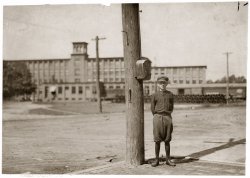
MAY CONTAIN NUTS

Search Shorpy
SHORPY ART

Framed or unframed, desk size to sofa size, printed by us in Arizona and Alabama since 2007. Explore now.
Join and Share
Ad-Free Shorpy
Shorpy is funded by you. Patreon contributors get an ad-free experience.
Learn more.

Recent comments
- Details, Details
- What's that building to the left of the tower?
- Coal Barges
- Bromo-Seltzer
- Inner harbor
- The Basin
- What a headache!
- Giant stepladder?
- Baldwin 62303
- Baldwin VO-1000
- Cold
- No expense spared
- Tough Guys
- Lost in Toyland
- And without gloves
- If I were a blindfolded time traveler
- Smoke Consumer Also Cooks
- Oh that stove!
- Possibly still there?
- What?!?
- $100 Reward
- Freeze Frame
- Texas Flyer wanted
- Just a Year Too Soon
- WWII -- Replacing men with women at the railroad crossing.
- Yes, Icing
- You kids drive me nuts!
- NOT An Easy Job
- I wonder
- Just add window boxes
Member Photos
The Shorpy
Print Emporium
Print Emporium
Search Shorpy
Search results -- 30 results per page
- Popeye and Friends: 1911
- August 1911. "Arthur Chalifoux (4th boy from left), 3 Rand St. North Adams, ... up a story about each one of them.
Popeye and Friends: 1911 This is Joe Manning, of the Lewis Hine Project. I interviewed one of ... for more information.
Popeye and Friends: 1911 This is Joe Manning again. My full story about Arthur Chalifoux is now ... Posted by Dave - 09/07/2011 - 5:14pm -
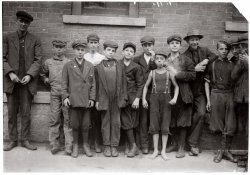
- The Apprentice: 1911
- February 1911. Biloxi, Miss. "Alma Croslen, 3, daughter of Mrs. Cora Croslen, of ... ever wash their childrens' clothes?
The Apprentice: 1911 This is Joe Manning, of the Lewis Hine Project. I just did two hours of ... which you've flaked with a kitchen knife.
Apprentice: 1911 Joe Manning again. This is shaping up to be quite a story. Two days ... Posted by Dave - 08/26/2009 - 6:23pm -
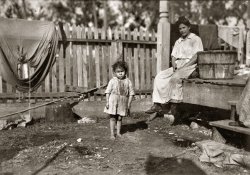
- Meet the Mauros: 1911
- New York. December 1911. "5 p.m. Mrs. Mary Mauro, 309 E. 110th St., 2nd floor. Family works on ... probably one of their sources of fun!
Meet the Mauros: 1911 This is Joe Manning, of the Lewis Hine Project. I recently interviewed ... provide decorative plumes for hats.
Meet the Mauros: 1911 This is Joe Manning, of the Lewis Hine Project. My story of this family ... Posted by Dave - 08/22/2012 - 9:05pm -
![Meet the Mauros: 1911 New York. December 1911. "5 p.m. Mrs. Mary Mauro, 309 E. 110th St., 2nd floor. Family works on feathers (sewing them together for use as a hat trimming). Make $2.25 a week. In vacation two or three times as much. Victoria, 8 yrs. Angelina 10 yrs. (a neighbor). Frorandi 10 yrs. Maggie 11 yrs. All work except two boys against wall. Father is street cleaner and has steady job. Girls work until 7 or 8 p.m. Once Maggie worked until 10 p.m." Glass plate by Lewis Wickes Hine. View full size.
Tic Tac ToeOn the wall is probably one of their sources of fun!
Meet the Mauros: 1911This is Joe Manning, of the Lewis Hine Project. I recently interviewed the daughter of the toddler who is sleeping in the arms of his brother. I will notify Shorpy when my story of this family is completed.
[Sounds fascinating! - Dave]
No way Tito!If googlemaps is to be believed, it would appear that section of East 110th St has been renamed Tito Puente Way. "309" is on the door.
View Larger Map
I want to knowI want to know more about the little one behind Mama, that can't help out.
Rock-A-Bye-BabyLooks like Mom figured a way to work and rock the baby at the same time with the rocker base on the crib, I like that! They seem pretty happy and look well fed even though they work long hours. Every hand helping for the good of the family. During this time learning sewing skills may have helped some of the little girls make their living or open a business later in life. Too bad most girls today have no such skills or interests.
Childcare circa 1922It's crafts day at the childcare center, except it has work and care.
Migratory Bird Treaty ActA major reason for passage of the 1918 Migratory Bird Treaty Act was to protect birds from being harvested for their feathers. Before the MBTA, it was estimated that a few million birds per year were killed to provide decorative plumes for hats.
Meet the Mauros: 1911This is Joe Manning, of the Lewis Hine Project. My story of this family is posted. I interviewed the daughter of the boy who is sleeping in the photo. Her interview still gives me goosebumps. This is one of my favorites among the many stories I have done.
http://morningsonmaplestreet.com/2015/01/18/mary-mauro-family/
(The Gallery, Lewis Hine, NYC)](https://www.shorpy.com/files/images/SHORPY_05482u.thumbnail.jpg)
- Rosina Goyette: 1911
- September 1911. Winchendon, Mass. "Rosina Goyette, Maple Street. Apparently 12 but says ... Lewis Wickes Hine. View full size.
Rosina Goyette: 1911 This is Joe Manning, of the Lewis Hine Project. Rosina lived into her ... Hine took 40 photos in Winchendon in September of 1911. I have been researching all of them for the past six months. You can see ... Posted by Dave - 04/08/2009 - 7:24pm -
![Rosina Goyette: 1911 September 1911. Winchendon, Mass. "Rosina Goyette, Maple Street. Apparently 12 but says she is 14; has steady job doffing and spinning in Spring Village Mill. Said at first she had been working six months, later she changed it to three weeks. Her partner said 'a few weeks.' " Photo by Lewis Wickes Hine. View full size.
Rosina Goyette: 1911This is Joe Manning, of the Lewis Hine Project. Rosina lived into her 90s. I recently interviewed her granddaughter. Hine took 40 photos in Winchendon in September of 1911. I have been researching all of them for the past six months. You can see a lot of what I have found on my website at www.morningsonmaplestreet.com/winchendon.html
Sad portraitShe looks like she is from the dead zone, not a pleasant childhood.
SPLASH!Toto, I don't think were in Kansas anymore. Toto?...Toto???
What does "partner" mean?What does "partner" mean? Is this girl married at her young age?
[It's a girl who works with her at the mill. - Dave]
It's Wednesday...... of the Addams Family. Her full name was Wednesday Friday Addams.
Rosina Goyette: 1911This is Joe Manning, of the Lewis Hine Project. I interviewed the granddaughter and daughter-in-law of Rosina. They live near me and visited my house. They had some terrific photos of her. Rosina lived to be 98 years old and was quite a colorful lady. You can see the whole story on my website.
http://morningsonmaplestreet.com/2014/11/26/rosina-goyette-page-one/
(The Gallery, Kids, Lewis Hine)](https://www.shorpy.com/files/images/02301u.thumbnail.jpg)
- Arthur Havard: 1911
- January 1911. South Pittston, Pa. "Arthur Havard, a young (mule) driver. Shaft #6. ... Lewis Wickes Hine. View full size.
Arthur Havard: 1911 This is Joe Manning, of the Lewis Hine Project. I just talked to ... of the past of our present. Thank you.
Arthur Havard: 1911 This is Joe Manning, of the Lewis Hine Project. According to a brief ... Posted by Dave - 01/01/2011 - 2:21pm -
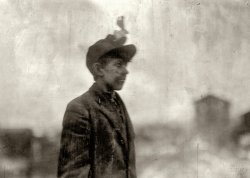
- Knitting Mill Boys: 1911
- ... Charlie McHorney, 4 Poindexter St., Winding Room. June 1911. Photo by Lewis Wickes Hine. View full size.
1911 Boys Notice how many are smoking?
1911 Boys One? MAYBE two! ... Posted by Dave - 07/14/2009 - 4:12am -
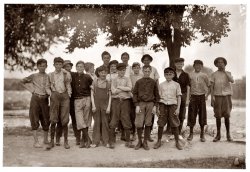
- Summer Intern: 1911
- June 1911. Norfolk, Va. "Teaching the Young How to Sell. Gus Hodges, age 11, ... Lewis Wickes Hine. View full size.
Summer Intern: 1911 This is Joe Manning, of the Lewis Hine Project. Based on several hours ... looking younger every year.
Julius and Gus Hodges: 1911 This is Joe Manning, of the Lewis Hine Project. I have posted my story ... Posted by Dave - 08/10/2012 - 1:47pm -
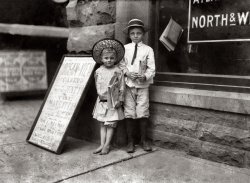
- Bustling Cleveland: 1911
- Cleveland, Ohio, in 1911. "Euclid Avenue." Painless dentists and quick-service lunchrooms in easy ... when the trolley pole passed through the sensor.
1911 Looking at this photo, it is kind of hard to believe this was the same year that John Moses Browning invented the 1911 semiautomatic pistol.
Wheels of Time The wheels on the cars, ... Posted by Dave - 07/12/2013 - 9:00pm -
![Bustling Cleveland: 1911 Cleveland, Ohio, in 1911. "Euclid Avenue." Painless dentists and quick-service lunchrooms in easy walking distance. 5x7 glass negative. View full size.
Wearing them outI would swear that trams identical to those pictured were still running on St. Clair Avenue in the late 1940s. Other lines (like the Rapid Transit from downtown to Shaker Square) had newer equipment, but the clunkers with rattan seats and open vestibules were my daily transport to kindergarten and first grade. My first wallet (fashioned of genuine imitation leather) contained but one thing: my trolley pass.
Lost & FoundBennet Fish is not the place for lobster or halibut but was actually a haberdashery. Its ampersand would be hiding behind that flag.
Chandler & RuddPart (about 2/3) of the Chandler & Rudd building on the right of the photo survives. It's the red building on streetview.
View Larger Map
Here is an article about the relocated Chandler & Rudd specialty grocery business closing after 145 years, although they later reopened as online-only.
The Euclid Arcade survives (a point of confusion, there were/are several Arcades near each other), but the old Hippodrome was demolished in 1981.
The photo was shot looking east from the southeast corner of Public Square. The box on the westbound trolley wire is a sensor to allow motormen to throw the switch remotely when approaching the square. This was done by either having power on or coasting when the trolley pole passed through the sensor.
1911Looking at this photo, it is kind of hard to believe this was the same year that John Moses Browning invented the 1911 semiautomatic pistol.
Wheels of TimeThe wheels on the cars, closest on the left, have wheel hubs that appear not unlike those on a chariot in King Tut's tomb. While roller ball bearings were being produced before 1911, it seems like the car makers couldn't quite figure out how to use them.
1911Actually, Browning's pistol was adopted in 1911, hence the name. It had been around for some time previously in various forms.
What is the tower on the Hippodrome? Radio communications? Broadcasting was almost 10 years in the future.
[Probably a wireless telegraphy mast. Many other contemporary examples can be seen atop urban buildings in Shorpy photos. -tterrace]
+105Below is the same view from July of 2016.
(The Gallery, Cars, Trucks, Buses, Cleveland, DPC, Streetcars)](https://www.shorpy.com/files/images/SHORPY_4a27497a.thumbnail.jpg)
- David Leung: 1911
- "David Leung in sailor suit, 1911." Platinum print by Fred Holland Day. Another look at the work of this ... photographer. View full size.
David Leung: 1911 I did about 10 minutes of research on this. David G. Leung was born in ... Posted by Dave - 09/13/2011 - 7:25pm -
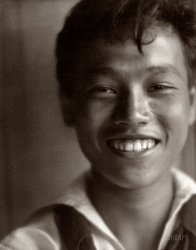
- The Train Shed: 1911
- Chicago circa 1911. "Train sheds, Chicago & North Western Railway station." 8x10 inch dry ... . - Dave]
Job Security Party scene from the 1911 version of The Graduate : "I want to say one word to you Ben -- ... the current train shed looks nothing like the one from the 1911 station. Those concrete lined openings in the roof above the tracks to ... Posted by Dave - 07/20/2012 - 3:42pm -
![The Train Shed: 1911 Chicago circa 1911. "Train sheds, Chicago & North Western Railway station." 8x10 inch dry plate glass negative, Detroit Publishing Company. View full size.
Twins reunited, and a challenge!I took the liberty of joining the two views we have of this exquisite train shed. Alas, the geometry suffers in my feeble attempt. However, a great deal of information about the soul of the space is nicely recovered, if I do say so myself.
I know there are better panorama stitchers than I on this forum, and I challenge you to attempt a stitch worthy of a full sized post!
Warning...this is a very tough stitch! The scales of the 2 photographs are different, and there is precious little overlap from which to establish the lens parameters. I suspect the original lens was 210mm on an 8x10 camera. The above is Photomerge's best shot, which required resizing the right side to 3080 pixels high. It simply defaults on correcting the geometry at the top, but in so doing does retain more details there than a normally stitched panorama.
Here's the righthand photo, which is a little smaller than the left, above.
So nice and cleanThe station is amazingly clean in appearance, but it looks like they have some peeling paint problems or corroding iron.
Absolutely,Stunningly gorgeous photograph. That is all.
Train Now LeavingTrain now leaving on Track 5 for Anaheim ... Azusa ... and CUC-amonga!
Next stop, EternityNow departing on Track 1, The Train to Forever!
Somebody cue the Twilight Zone music, thanks. Just follow the light at the end of the tunnel.
What a gorgeous image!
Where was this?I would love to know where in Chicago this was and what became of it. Do tell, Shorpy Nation.
[The former North Western Terminal, renamed Ogilvie Transportation Center, is at 500 West Madison Street. - Dave]
No Smoking!Centered above each track is an opening in the shed roof running the lenghth of the building. From here, exhaust smoke from the locomotive passes directly outdoors, making the platform area livable. Idea applies to today's diesels too.
ExpectingThe Silver Streak on Track 2 in 5 minutes. RUN!
Still aroundUnion Pacific trains now depart from here to Chicago's west, northwest and northern suburbs. Minus the trains, it looks pretty much the same, right down to the trainmen's uniforms.
Not Gone NowGone Now's information is erroneous. That train shed has not been demolished. I exited a Union Pacific train into this exact shed this morning, as did 10's of thousands of others.
C&NW RyWow. If I were to see this scene in a movie, I would be complaining that it looked like the typical backlot street scene - pretty, but too clean to be believable, not 'lived-in' enough. And in Chicago, no less!
North-Western TerminalThe tracks and sheds may still be there, but the beautiful waiting room ("Head House" building) was demolished in the late 1970s/early 80s to make way for something new. It had a beautiful green/yellow marble interior. There was a valiant effort to preserve it, a la Grand Central, but alas, to no avail.
Gone nowOther than the equipment, the CNW shed looked pretty much the same through the late 1970s when I first began commuting to downtown Chicago. It has since been demolished and replaced, just like the old CNW terminal. The new shed now deposits you into the Citibank Center building. Thank goodness Union Station is still in use! I love the look and feel of an old-timey big city train depot.
What are these?I see more down the track so I assume they are above the other tracks as well.
[It's electrical power for the train cars after they've been disconnected from the locomotive. See this thread. - Dave]
Job SecurityParty scene from the 1911 version of The Graduate: "I want to say one word to you Ben -- rivets!"
Yes it is GoneThe train shed has been completely rebuilt, as have the platforms and tracks. The actual "building" of the train shed remains, like the exterior walls and the overall structure below, but all the concrete and steel has been replaced at this level. What's there now is a much more angular canopy structure, without the curving beams. Unfortunately, because the Metra commuter trains that operate into this station back in, there's no need for the smoke shafts to extend very close to the head house, so it's quite a bit darker now.
http://www.panoramio.com/photo/41278935
Great detailsThese old photos amaze me with details you can see.
Nice shine on that conductors shoes!
All GoneNothing in this image exists today. In the early 1980s, the North Western Station head house was demolished, to be replaced with Citicorp Center. In the mid 1980s, the train shed and the trusses supporting the tracks were removed, replaced with completely new structures. Only the outer walls were repaired. Metra wanted to replace them to look like Citicorp Center but balked at the extra expense. Obviously the current train shed looks nothing like the one from the 1911 station. Those concrete lined openings in the roof above the tracks to allow smoke from steam locomotives to exhaust was a unique feature of this shed, but for the last couple of decades of its life, the concrete was badly cracked and deteriorated and chunks fell off regularly.
Inside, Outside
It was a wonderful time to ride the trainI used to use this terminal every day as a young adult since I rode the train into the C&NW terminal Monday through Friday. It does exist on film since they used it for the last minutes of the movie "Silver Streak." That is that train yard they are "rushing into". I think they used parts of it for the last scenes, too.
Anyway, best times I ever had going to work was when I rode that train. Great pictures.
Another image stitchingI resized the smaller image so that objects in the overlap were roughly the same size, then stitched the two in PTGui Pro 9.1.2.
It did a little better in the area near the ceiling, although the lens parameters created some pincushion distortion near the center of each image. A little bit of Spherize distort in Photoshop cleared most of that up.
Really enjoy these panoramas from back in the day. I stitch 360x180 images in the modern day.
(The Gallery, Chicago, DPC, Railroads)](https://www.shorpy.com/files/images/4a24216a.thumbnail.jpg)
- Office Cubicle: 1911
- Cleveland, Ohio, circa 1911. "Brotherhood of Locomotive Engineers Bldg., St. Clair Avenue and Ontario ... Posted by Dave - 11/13/2023 - 2:36pm -
![Office Cubicle: 1911 Cleveland, Ohio, circa 1911. "Brotherhood of Locomotive Engineers Bldg., St. Clair Avenue and Ontario Street." 8x10 inch dry plate glass negative, Detroit Publishing Company. View full size.
The whole building?B of LE Building ... does that mean the brotherhood used the whole building?
[They owned the whole building. - Dave]
Full frontalSo we get the glamour shot of what we only had a tantalizing glimpse of a half-year ago. Still around, and still durned impressive ... or incredibly monotonous, depending on your preferences.
[Er, no. That "tantalizing glimpse" was of a different building. - Dave]
We can take comfort in being wrong together: you're pointing to the building across the street - which wasn't built until a decade after this picture, and I was mistaken that this is extant ... sadly
StaredownIs that a Studebaker electric facing off with that horse?
No Safety BarriersThe unfinished streetcar tracks catch my eye and how it is not surrounded by any sort of safety barriers - another reminder of how it was a different time back then. Also, wonder what the BoLE Auditorium looked like. Probably not as ornate as what would be created in another 10-15 years.
Safety lastA torn up street and no barricades or traffic cones. Must have been before personal injury lawsuits were invented.
At home in ChicagoThis style is from the Chicago School of architecture, which emphasizes the building's structural grid, uses relatively little ornamentation, and has large plate-glass window areas. I think it's a good look, especially considering that buildings would eventually be clad in only glass curtain walls.
(The Gallery, Cars, Trucks, Buses, Cleveland, DPC, Railroads, Streetcars)](https://www.shorpy.com/files/images/SHORPY-4a24063a.thumbnail.jpg)
- Manuel Labor: 1911
- August 1911. Fall River, Mass. "Group containing the following boys who work in the ... first word of the caption. - Dave]
Manuel Labor: 1911 Fall River is one of several cities in southeastern Massachusetts with ... Posted by Dave - 09/13/2011 - 6:35pm -
![Manuel Labor: 1911 August 1911. Fall River, Mass. "Group containing the following boys who work in the Sagamore Mfg Co. Manuel Correira, 144 Cove Street, works in Spinning room on top floor. Said, 'I only help Mother.' He was apparently 13 or 14. Manuel Oliver, George Street, works in card room. Seems surely only 12 years old. Manuel Benevirdes, 30 Otto Street, works on top floor. Manuel Rage, 51 George Street, works in spinning room on fourth floor. John Oliver, 93 Slater Street, works in spinning room on third floor. Joseph Ariuda, 23 Shorr Street, works in spinning room on third floor." Photo and caption by Lewis Wickes Hine. View full size.
Too poor for shoes?Judging from the clothing it's not summertime. Yet three of the boys are at work barefoot.
[A good hint as to time of year can be found in the very first word of the caption. - Dave]
Manuel Labor: 1911Fall River is one of several cities in southeastern Massachusetts with a large population of Portuguese immigrants, so there would have been many Manuels living there at the turn of the century. Still, I wonder if Hine thought these boys were trying to play a joke on him.
Lizzie Borden Axed Her Parents.......and their home still exists in Fall River, Mass. on a list of historical places. The town was brimming with endless large and small textile and knitting mills of all sorts in the l8th, 19th and 20th centuries. When I lived close by in the late 1950's,early 60's, one could actually have a sweater knitted to one's own specifications (color, size and style) for a relatively low price, about $10 to $15 and I did take advantage of that. No more though, those days are gone forever, but I did love those sweaters.
Expecting rainDoes the guy on the far right know something nobody else does?
Speculation I'm not sure why but the umbrella seems like an odd item in this picture. Also the ladies in the back. . . I wonder what their relationship is to the boys and/or the building. This site is sucking way too many hours from my day but each picture is more fascinating then the last.
Everybody Vogue!I love the poses these kids have struck. Do you think it was on purpose or at the photographers request? They sure are a cute little bunch. Those two on the left look full of fun.
SurnamesI believe the correct surnames must be Correia (Correira), Oliveira (Oliver), Benevides (Benevirdes) and Arruda (Ariuda).
(The Gallery, Factories, Kids, Lewis Hine)](https://www.shorpy.com/files/images/02257u.thumbnail.jpg)
- Cold Comfort: 1911
- Heat wave in New York. July 6, 1911. "Licking blocks of ice on a hot day." 5x7 glass negative, George Grantham ... Cheap Groceries, too. I miss Fancy Cheap Groceries.
1911 Heat Wave It was 97 degrees in Manhattan today. I didn't see anybody ... of Congress, they say it was published July 6, 1912, not 1911. How did Shorpy come up with the 1911 date? 1911 makes sense since there ... Posted by Dave - 09/11/2011 - 10:58am -
![Cold Comfort: 1911 Heat wave in New York. July 6, 1911. "Licking blocks of ice on a hot day." 5x7 glass negative, George Grantham Bain Collection. View full size.
Heatwave...Wow, what I would have given to be one of those kids on a hot day like today. I would have been happy to just sit on the ice!
[That was the line across the street. - Dave]
How... unsanitary.
Cold ComfortI remember back in the 60's in Chicago we'd chase the milk trucks delivering in the neighborhood to beg some block ice to help with that oppressive heat and humidity...... and they were glad to give it out . He'd chip off a chunk to give to each kid and we'd be happy campers.
Fancy Cheap GroceriesThe ice looks just fine; the temperature touched 101 here today and those kids have the right idea. I could go for the Fancy Cheap Groceries, too. I miss Fancy Cheap Groceries.
1911 Heat WaveIt was 97 degrees in Manhattan today. I didn't see anybody licking ice. I saw people walking very slowly. I heard the steady hum of air conditioning units, but no children in the streets of midtown. Perhaps in the familial neighborhoods of the city there were children on the streets under the gush of hydrants but it isn't a sure thing anymore. It's much easier to cool off now.
I wishI WISH it was hot enough to even think about licking ice here in Washington State. A balmy 48 with buckets of rain.
PhoenixI wish it were possible to put out large blocks of ice to cool down here in Phoenix. Eight a.m. sees almost 90 degrees already. Those things would melt before a tongue even touched them.
Smiles in the summer heatI love the kids faces. They all look so pleased. But as a mother all I can think about is the number of germs they'd be spreading, all sucking on that block of ice. -- Summer in the city was such a time for polio and other diseases to spread. Looking at those kids, some of them are pretty grimy. There's a clutch of fear that crawls into my heart looking at them, imagining that they're my children.
I like the progression of hatsCloth caps on the boys, porkpies on the young men and a derby on the older man.
July 6In the Bain collection at the Library of Congress, they say it was published July 6, 1912, not 1911. How did Shorpy come up with the 1911 date? 1911 makes sense since there was a record shattering heat wave that July, but how does Shorpy know the date?
[The Library of Congress citation for this image doesn't say anything about 1912. "7/6/11" is the date written on the negative. The other negatives from the same group (LC-B2-2301) of nine photos are also dated 1911. - Dave]
(The Gallery, G.G. Bain, Kids, NYC)](https://www.shorpy.com/files/images/09814u.thumbnail.jpg)
- Sagamore Mill Boys: 1911
- August 1911. Fall River, Mass. "Group containing the following boys who work in the ... the "texter") from your 01/17/2010 post "Manuel Labor: 1911".
https://www.shorpy.com/node/7498
Not quite fair that one ... had a lifetime to work it all out.
Sagamore Mill Boys: 1911 This is Joe Manning, of the Lewis Hine Project. I just tracked down the ... Posted by Dave - 06/27/2011 - 10:54pm -
![Sagamore Mill Boys: 1911 August 1911. Fall River, Mass. "Group containing the following boys who work in the Sagamore Manufacturing Co. Manuel Correira, 144 Cove Street, works in spinning room on top floor. Said, 'I only help mother.' He was apparently 13 or 14. Manuel Oliver, George Street, works in card room. Seems surely only 12 years old. Manuel Benevirdes, 30 Otto Street, works on top floor. Manuel Rage, 51 George Street, works in spinning room on fourth floor. John Oliver, 93 Slater Street, works in spinning room on third floor. Joseph Ariuda, 23 Shorr Street, works in spinning room on third floor." Photograph by Lewis Wickes Hine. View full size.
Tough or serious?Nearly every photo of this type from this era shows the boys doing their best to look serious or tough. You wonder if it had more to do with wanting to looking grown up or more about not letting their guard down.
Text-tilesIs the fellow at the far right texting his sweetheart that he is running late due to a photo shoot?
Facebook updateThe fellow on the right is obviously doing a status update on his iPhone or possibly checking his cash situation.
Some things never changeThat guy on the right is texting, right?
Mr tough-guy!Love the attitude of that the kid with the crossed arms. He may not be the oldest or biggest, but he must be one of the leaders, what with the attitude, and better clothes, he seems to be saying "these are my boys, so back off!"
Industrial RevolutionSeems like this mill needs to join the Industrial Revolution. Most of the work is being done by Manuel labor.
Fancy HandleOn that bumbershoot held by the young man third from the right!
A different kind of educationI know the child labor movement was a platform that had to be dealt with due to abuse, etc. However, these kids were getting a different kind of education, learning responsibility, what it took to earn money, following rules, how to cooperate and work with others, the ability to help their families improve. Perhaps they couldn't spell and/or read perfectly, etc. but neither were they out in the streets in gangs, planning drive-bys and home invasions. I notice these days when youngsters get in serious trouble, their elders say "they need someplace to go and something to do." The kids pictured here were helping, not hurting anyone. Yes, I am a cranky old curmudgeon, wanna make somethin' out of it?
What's in a name?Didn't Lewis Hine find it sorta suspicious that the first 4 guys in his photo were all named Manuel? Seems to me there's some obfuscation going on there. Or maybe they're all engaged in Manuel labor!
Kid lounging on rightThat kid on the right is Butch from Our Gang Little Rascals, and he is counting the lunch money he just took from another kid.
Manuel labor?Apparently the trendy name among Hispanic parents at the turn of the century was "Manuel"!
The first thing I thought was that the kid at far right looked like he was texting, or some such, too. These boys had probably never even seen a telephone, let alone communicated with their friends any way but face to face, and they had very little time even to do that! I wish I could put my teenaged kids in a time capsule and make them spend a day or two doing what these boys did all the time.
Multiple ManuelsWhenever a mother in Fall River yelled, "Manuel," she must have been trampled to death . . .
More seriously, who knew there were so many Spanish-surnamed immigrants in Massachusetts in the 1910s? Where did they come from? And why did they choose to settle there?
[Most of these names are Portuguese. In percentage terms Fall River has the largest Portuguese American population in the United States. - Dave]
More Manuel Labor?My first post, but I must be spending way too much time on this site. I immediately recognized these young workers (minus the "texter") from your 01/17/2010 post "Manuel Labor: 1911".
https://www.shorpy.com/node/7498
Not quite fair that one guy has an as-yet-to-be-invented device, while the second kid from the left doesn't even have shoes. . But I suppose they had a lifetime to work it all out.
Sagamore Mill Boys: 1911This is Joe Manning, of the Lewis Hine Project. I just tracked down the 90-year-old son of one of the boys in the photo, Joseph Ariuda (actually his name was Arruda). I haven't called the son yet. But Hine did not identify who was who in the caption. So I hope that someone in the Arruda family will recognize him. This could be interesting.
Sagamore Mill Boys 1911Joe Manning again. Here's an update. Just talked to Joseph Arruda's grandson. He didn't know about the photograph. I am mailing it to him. He thinks he will be able to identify which boy in the photo is Joseph. He remembered his grandfather well, and told me, "He was a great man in my opinion." By the way, Joseph named one of his sons Manuel!
(The Gallery, Factories, Lewis Hine)](https://www.shorpy.com/files/images/02258u.thumbnail.jpg)
- Ghost Depot: 1911
- Circa 1911-1915. "Chicago train sheds, Chicago & North Western Railway." Barely ... Center (née Northwestern Atrium Center) replaced the 1911 terminal building in the mid-1980s.
Regarding the cleanliness - the station was built in 1911, so the Shorpy photo depicts a shiny brand-new station.
The Reel Thing ... Posted by Dave - 07/22/2012 - 7:07pm -
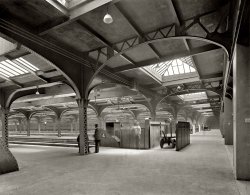
- Forest Brook: 1956
- ... rural Kansas. We were in a building that had been built in 1911 and only housed six grades. The 7th and 8th grades were in the high ... had been moved into town and put behind the school. The 1911 building was probably a horrible firetrap, although there was a metal fire ... Posted by Dave - 02/14/2013 - 7:14am -
![Forest Brook: 1956 November 8, 1956. "Forest Brook Elementary School, Hauppauge, Long Island. Classroom and teacher." For those of a certain demographic, this may strike a chord. Large-format negative by Gottscho-Schleisner. View full size.
We never did that.I grew up in the suburbs around Akron, Ohio, and we never had a bomb drill or duck-and-cover drill ever. All of my peers that grew up in other places had those drills, which has led me to a couple of possible theories. One, that we had some sort of pacifists in our local administration that refused to take part in the Cold War(unlikely). Or two, that we were so close to potential industrial targets that there was simply no point in hoping for survival... Better to go out in the first flash.
[Never had them in my grade school years 1952-1960 in Larkspur, California, either, nor was I aware at the time that they were going on anywhere. -tterrace]
Lighting fixturesWe had very similar fixtures in my Elementary School about ten years after this, ours had a large bulb with the bottom painted silver sticking through the center though.
They were probably ancient even in 1966.
X marks the spotI'm not sure if it looked that way in 1956, but Forest Brook today has a strange shape, what you might get if Picasso or Dali had been asked to draw the letter X.
Hauppague today is a densely populated community, home to most of Suffolk County's government (though Riverhead is the actual county seat) and a huge industrial park, but back in 1956 it was on the frontier of suburbanization. I wouldn't be surprised if some of the students in this picture were the children of farmers.
You will not leave this house dressed like thatIt would be three years before I entered first grade about 20 miles west of Hauppauge. The New York City Board of Education had a much less relaxed dress code. Boys from first grade on had to wear ties. Jeans and sneakers were not permitted. On school assembly day everyone was required to wear a white shirt or blouse and the boys had to wear red ties. Of course by the time we were graduating from high school there were still strict dress standards, but they only applied to the teachers.
Smelementary SchoolThose wooden desks were washed and cleaned before classes three months ago, and the floors are waxed weekly.
All the girls are in skirts or dresses, and the boys are well groomed and always polite. After all, no one wants to get called down to the school office!
Plus, there's a great lineup of cars out the window, in case a little daydreaming is in order, but only for a few seconds at a time. By the way, you can smell today's newfangled hot lunch almost ready to serve, down the hall.
Let there be photonsMy elementary school (Horace Mann in Burbank, Calif.) had the same light fixtures, although we had four to a room. Each contained one ≈500 watt bulb; the bottom of the bulb was obscured by a silver coating. When a bulb was nearing the end of its service life, it would usually emit a high-pitched squeal. The teacher would then cycle the light switch off and on several times, killing the bulb and throttling the distracting squeal.
Reading MaterialMost of the children have notebooks, many children seem to have the Spell and Write workbook, and the young man in the lower left (just behind the girl in the foreground) has the Air Raid Instruction booklet on his desk.
My First Year of School1956 was my first year of school in Houston. Would have loved to have been able to wear blue jeans and shirt tails out but HISD rules at the time (and almost all the way through my HS years) said no blue jeans, no t-shirts, no shirt tails out for boys and skirts/dresses only for girls.
Hard to believe especially since the schools weren't air conditioned in HISD except for offices and a few other classrooms (science for one)until after I graduated in 1968.
No duck and cover drills for us until the Cuban missile crisis when we were told Houston would be a first strike target due the refineries throughout the Houston area. We had an air raid siren right next to the window in my 5th grade class that went off each Friday at noon. I also thought to myself that if the Russians were smart they would attack at noon on Friday!
Star pupils or problem children?Teacher has all that space in front of the classroom for her desk but it's right up close to those pupils at the far end of the classroom. Even with the photographer present, the kids appear to be gazing out the window. Maybe she needed to be that close to keep their attention for any length of time. I wonder if modern medicine is overused in favor of such simple solutions.
Maybe I'll send the first grade picture (1960) from my Catholic school in New Jersey. It's a bright, clean classroom like the one shown here but it's packed tight with baby boomers, all in navy blue and white uniforms, with Sister in her black and white habit up front.
1956 RebelAlright, who's the non-conformist on staff who just had to park facing the wrong way?
Sturdy Desks and the "Good Old Days"Those sturdy desks are perfect for the inevitable "Flash Drills" of the era, in which the principal would come into the room unannounced and write "FLASH" on the blackboard, causing all of us students to "duck and cover" to avoid instant nuclear incineration. I'm not sure how much good it would have done in a real attack, but it was the only tool in the drawer.
Also, I'm surprised the windows don't have the standard heavy blackout curtains, which were handy not only for viewing nmovies but to keep enemy bombers from spotting stray lights at night.
And a decade laterI started public school a decade later, in a building constructed in 1961. And it was exactly like this, light fixtures, desks, and all. Most of the teachers were young then (and exactly one man, who I got in fifth grade) but I started out with Mrs. Lord, the white-haired wife of the principal, who could have stepped out of any 1910 school administrator picture with naught more than a change of collar. However in my day the fellow with the open shirt front there would have been made to neaten himself up.
Beautiful Schools but the Russians are coming!I began my second semester of kindergarden in January of 1953 in newly built grade school on the west side of Detroit. We immediately began having fire and air raid drills. For air raids we descended into the basement of the school which was actually the main tunnel of the air circulation system. Some times when we went down the stairs during a drill, the big fan would still be rotating after being shut down. We had to sit along the walls and cover our heads. To condition us further the lights would be turned off for a short period of time. I switched to a newly built parochial grade school for the fourth grade on. No basement, so we sat in the main hallway between the class rooms and covered our heads. Both schools had class rooms identical to Forest Brook. To add to the tension, the nearby Rouge Park had a Nike missile battery. The missiles were normally hidden behind a high earth berm, but they were visible when frequently pointed skyward for testing. The AM radio frequencies of 640 and 1240 were permanently etched into our memory.
DrillsI'm exactly the right age for these memories, but except for a few very early instances that were termed "air raid," all our drills were of the fire kind. No duck, no cover - and this just north of San Francisco, with its own battery of Nike missiles by the Golden Gate - in plain view if you took a spin along the Marin Headlands. We all just marched outside. The only time we had to put our practice to use was for a 1957 earthquake centered just south of SF but sharp enough in Larkspur to get us squealing in our fifth grade classroom before the alarm sounded and we made our orderly exit.
"Silver Tooth"I was in the ninth grade in fall of 56. All of the new schools I attended in the late 40's and 50's had those windows and the 9 inch floor tiles. I believe the teacher's desk was in that position only for this pic. One memory came to me in a flash when I saw the tiles. In the 4th grade on the last day of school as I was swinging between desks I did a face plant on the green floor tiles. The impact broke off two of my front teeth below the nerves and the family dentist fixed them with silver caps that stayed that way until I turned 21.
Blue Jeans?I was in 5th grade at the time, in a far western suburb of Chicago. What I remember was the enormous spending on shiny new schools back then. My mom was a teacher, back when teaching was a respected profession, teachers were proud of what they did for a living and grateful for the $6,000 a year they were paid.
That and the rule against blue jeans. Strictly verboten in my school system. They looked "hoo-dy", pronounced with "hoo" as the first syllable, and were a a well known precursor for the dreaded juvenile delinquency during adolescence and a life of crime and depravity later on. Without that rule, thank goodness and a vigilant school board, I probably would have a criminal record by now.
Good Ol' '56I was in third grade in Hempstead, Long Island then. Ike was president and the world 'champeen' Brooklyn Dodgers would win another pennant only to lose once more to the Yanks. Anybody who wore dungarees (as jeans were called then) in my school district would have been sent home to change to proper attire and an open shirt would catch you a stiff reprimand. Nobody knew what a school bus was and schools were not in the restaurant business for anybody. There was a lot to like about those days.
Fond MemoriesI was in 1st grade at that time and our classroom in suburban Chicago looked very much like this one. Someone mentioned getting called down to the office. There was nothing worse than hearing your name on the PA system to report to the principal. Every kid in school knew you were probably in deep doo doo. As for the non-conformist staff member who backed into his spot, these types have always been around and still are today. They'd rather waste extra time and endure the hassle of backing into a parking spot just so they can pull out with ease at the end of the day. Never understood that logic.
The Joys of childhoodI would have been 9 years old when this photo was taken. I was attending "Summer Avenue School" at that time. It was an old three story brick building. We had the kind of desks that bolted to the floor so they couldn't be moved even if you wanted to do so. The seat was actually part of the desk behind you and folded up automatically when you stood up. The top of the desk was hinged at the front so that you could lift it up and put you books and such inside. Oh Yes, they had the obligatory inkwell hole in them as well, but never any ink.
Summer Avenue School still stands but is now known as Roberto Clemente Elementary School.
The desksStarting I guess in the late 40s that blonde style of wood came very much into vogue for furniture. Notice, they're the first generation of school desk withOUT a hole for an inkwell. We had ball point pens by then, no more dipping a nub into india ink. And no more opportunities for dunking the pigtail of the little girl in front of you into the ink!
The furthest cornersAh, those desks. In the later grades of elementary school we ate our lunches in the classroom, and the kid in front of me used to stuff the parts of his lunch he didn’t want into the deepest recesses, behind books and other trash. It got very ripe, and one day the teacher followed her nose to Robert G.’s desk and made him excavate the smelly mess. I will leave the rest to everyone’s imaginations.
4th grade for meDecatur Street elementary. I think the building was probably built at the turn of the last century. And probably the teachers. We had the well worn student desks that you find in the antique shops now for a pretty penny. The one with the ink well and indentation for a pencil with the seat back and foldup seat on the front of your desk. We had 12' ceilings, oiled wood floors that the janitor put sawdust down on daily to use his pushbroom on, kept the dust down.
Old School, New SchoolI started the first grade in 1954 in rural Kansas. We were in a building that had been built in 1911 and only housed six grades. The 7th and 8th grades were in the high school. The bathrooms, the lunchroom, and the art room were all in the basement, and we had music in a one-teacher school building that had been moved into town and put behind the school. The 1911 building was probably a horrible firetrap, although there was a metal fire escape on the back from the second floor down. The district built a new school in 1956, and we moved in in February 1957, when I was in the third grade. It looked much like the one in the photo, except that we had metal desks. No dress code--nearly all the boys wore jeans. That 1956 building is still in use, along with the 1923 high school. Of ocurse, they house far fewer kids than they did then.
Several years laterI was attending a Catholic school in a much older building further west on Long Island -- still vividly remember our "duck & cover" drills as I was the smart-alack who asked how a wooden desk would keep us from burning to a cinder.
As for the cafeteria, no hot lunch then; if you forgot your brown bag (no lunch money; you were not permitted to leave the premises) you might have been lucky enough to be escorted across the street to the convent for a PB&J sandwich.
The uniforms were ghastly -- white shirt, dark maroon tie with the school shield on it, and dark grey slacks with black piping down the outside seam. Girls wore a white blouse with a snap tie, grey plaid skirt (that was always rolled up at the waist after leaving the house, and a matching bolero. Once out of sixth grade boys wore a blue plaid tie & girls could wear a -- *gasp* -- blouse of color.
Reminds me of another picture here of young girls wearing skirts in the dead of winter; evil little Catholic boys that we were, we'd spend the lunch hour in the schoolyard assaulting the bare-legged victims by snapping rubber-bands on their frozen legs.
Not non-conformism. Safety!I've worked at a school for years and even though I'm not much of a rebel, I've always backed into the parking space. The logic is simple: you have to back up when you arrive or when you leave, and it's safer to back *in* to a space when there are few or no children around (an hour or two before school starts) than to back *out* of a space when children are running all around at the end of the school day (of course, one should triple-check either time). I often back into shopping center parking spaces using the same reasoning: if there's no one around when I arrive, it's safer to back up then than later when there might be a lot of people about. I knew a man many years ago who fatally backed over his 4-year-old daughter in their driveway and that tragedy changed my thinking on this permanently.
Reminds me of...Sutton Elementary School, southwest Houston, 1971 to 1973. The building was built in the late 50s and had those same big windows, but by that time we had the one piece metal desks with the big opening beneath for your books.
Few years laterI was in the first grade in a Catholic school in NYC. We had fire drills but no under the desk kiss your butt goodbye stuff. Nuns ruled the roost in those days. Midget Gestapo agents all in black with a yardstick bigger than them which was used to get you back in line if you misbehaved. I remember the first day of 2nd grade while us kids were waiting for school to open and my mom approached me to wipe my nose and the nun smacked her hand saying "he belongs to us now!" Ah memories...
Patty Duke, Ben Gazzara, Gene Hackman were some of the actors who lived in the area, Kips Bay, and might have even attended my school at one time.
"Snaggletooth"I can sympathize with jimmylee42. I broke a front tooth in much the same way at my school in the fourth grade. It was the winter of '63-'64.
When the weather was exceptionally cold, they would open the gym for the early kids to come inside before classes started. Although the details are vague now, someone said I was tripped by a bully while I was running around. In a family of four siblings my folks couldn't afford to get my missing tooth capped for years. So one of my nicknames throughout grade school was "Snaggletooth"... not one of my fonder memories. I finally got a white tooth cap just before I started senior high after we moved to Florida.
I wonder how my Alabama classmates would remember me now?
Yes, the Memories!I would have been right in this age range, near as I can tell from looking at the kids. That would have made it my first year out of parochial school, escaped from 4th grade under the rule(r)Sister Rita Jean, she who was Evil Incarnate.
Best memory was teacher telling me, "David! Stop moving your desk around. It makes me think we're having an earthqu... Everyone - outside!!"
DaveB
WonderfulGrade school in Alexandria, Louisiana. Very familiar classrooms, with the good Nun up front to keep [or try to keep] us on the right path.
Bayou View SchoolThis reminds me of Mrs Powell's 2nd grade class at Bayou View School in Gulfport, Ms, c.1955.
Fast ForwardTwenty years later I attended a school built in the early 1940s. This reminds me of those old classrooms in some respects with the desks all lined up in rows, large windows and undoubtedly a large slate chalkboard just out of view. I notice that the teacher's chair is a sturdy wooden straight back chair - no comfortable office chairs here! Also, only a two drawer filing cabinet? I don't think I've ever seen one that small in a classroom. I teach school now and while this brings back memories (even the light fixtures), it's amazingly different today.
Green ThumbThe teacher has quite a spartan setup, but I love the line of flowers along the windowsill! What a lovely touch that would be in a classroom.
This was a fun photo and I enjoyed the comments. My parents were born in 1954 and I really like seeing and reading about what that might have been like.
I grew up in that town!I didn't go to this school, but grew up in Smithtown--where this school actually was; not Hauppauge. I was in elementary from 1990-1995, when times were much different. As a teacher I love seeing how it was then.
Love this photo but makes me sadIf I could push a button and go back in time and be someone someplace in the past, I'd be on my way to being one of the kids in that classroom. This is public school education when it was about education.
(The Gallery, Education, Schools, Gottscho-Schleisner, Kids)](https://www.shorpy.com/files/images/SHORPY_5a24730u.thumbnail.jpg)
- German American Bank: 1911
- Circa 1911. "Postal Telegraph Cable office below German American Bank. Possibly ... Note the chain on the rear tire. - Dave]
1911 Torpedo Runabout That Model T Ford is a rare 1911 "Torpedo Runabout" from about the middle of 1911. Early models had a ... Posted by Dave - 08/21/2012 - 11:20am -
![German American Bank: 1911 Circa 1911. "Postal Telegraph Cable office below German American Bank. Possibly Detroit, Michigan." Downstairs: Lafayette Barber, offering Shower and Needle Baths, and something to do with electric vibra[...]. View full size. For a closeup of the Model T, click here. For the rest of the building, see this post.
One ClueIs the street sign next to the bank entrance.
Where to get your needle bath!Looks to me to be the corner of Lafayette & Griswold, looking south. To the far left is a glimpse of City Hall & in the background is the Hammond Building. Now about that needle bath ...
Nice brass-radiator Model T FordThe driver must have had to contort himself severely to honk the horn.
Barber caught shortGreat illusion here of the basement tenant entrances looking like doorways for the Seven Dwarfs. Fantastic livery abounds here plus that barbers pole is so iconic. I assume it is electric and it turns showing a twirling red, white and blue.
Give a toot!Very serious horn mounted on the side of the roadster.
[Click to embiggen. Note the chain on the rear tire. - Dave]
1911 Torpedo RunaboutThat Model T Ford is a rare 1911 "Torpedo Runabout" from about the middle of 1911. Early models had a square gas tank which was superseded by the round one on this car. Not all that popular when they were new, they are rarely seen and treasured by collectors today. Possibly the sportiest Model T made. Most 1911 Ts were painted a very dark, almost black, blue. It would not be until the 1914 Fords that you could get any color so long as it was black. Red, green, and grey were common in the very early Model Ts.
(The Gallery, Cars, Trucks, Buses, Detroit Photos, DPC)](https://www.shorpy.com/files/images/4a26718a.thumbnail.jpg)
- The Devil's Workshop: 1911
- August 1911. Eastport, Maine. "Group of young cutters, Seacoast Canning Co., Factory ... how good my childhood was.
The Devil's Workshop: 1911 This is Joe Manning, of the Lewis Hine Project. I have tracked down the ... but it was not about the working conditions for kids in 1911, more depression era personal stuff. Also I'm guessing they were on ... Posted by Dave - 06/07/2009 - 12:56am -
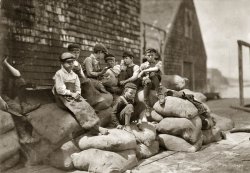
- Louise Cromwell: 1911
- Louise Cromwell poses in fox furs, c. 1911. This is likely the wealthy heiress who married General Douglas MacArthur ... woman, and photo. I know the furs are passe', now, but in 1911 were probably considered to be all that. Previous comments about wealthy ... Posted by Ken - 07/27/2012 - 12:26pm -
![Louise Cromwell: 1911 Louise Cromwell poses in fox furs, c. 1911. This is likely the wealthy heiress who married General Douglas MacArthur on February 14, 1922. View full size.
I shall returnWhat is she holding? The thing around her neck is dead, but is she holding a dog thats alive? She is a very pretty women and I am sure MacArthur used her as a basis for "I shall return"
Another furThat's another fox in her lap. Most certainly not alive.
Beautiful portraitIt's kind of a shame people don't dress like that anymore. (And I don't mean the wearing of dead animals. I mean the fashions of the era.)
19th CenturyThe photo's pose and lighting remind me very much of J. M. Whistler and other 19th century society painters.
Another Fur Is...What the lady is harboring on her lap looks to be a muff, which is a tube made of fur or other fabric often lined in silk, which a lady would tuck her hands into, and carry.
I can't believe I had such a thing when I was a small girl, I think a little white rabbit or three died for that set.
There was also a (hideous) fashion of using the various animal's body parts as seen in this photograph.
My grandmother gave me a fur piece which was three pine martens end-on-end, each has its little skull clamped onto it's brother's hind-end. The little eyes were glass beads. Wish I still had it, my cat ripped it to shreds in sheer terror I'm sure. It scared the heck out of me to merely touch it.
WOW!She's gorgeous. Oh, for the day when a wealthy heiress posed gracefully while fully and beautifully dressed (albeit with the corpses of furry animals). Instead of - you know - flashing their various shaved body parts while stumbling in and out of sleazy nightclubs.
ewI never understood the reasoning behind leaving the heads on.
Maybe notHe would rather stay away from her.
Gorgeous!This is an heiress with dignity and style. The photo reminds us how far downhill we've come in just 96 years. The heiress of today is in court, jail, or rehab while bragging that she doesn't wear furs!!
They divorced in 1929Wife: Louise Cromwell Brooks (m. 14-Feb-1922, div. 1929)
Wife: Jean Marie Faircloth (m. 30-Apr-1937, until his death)
http://www.nndb.com/people/025/000043893/
Louise CromwellWhat a breathtakingly beautiful woman, and photo. I know the furs are passe', now, but in 1911 were probably considered to be all that. Previous comments about wealthy brats with no panties on and showing that fact to the world, thinking they're so sexy, can't hold a candle to what is shown in this photo. It's called class.
sadShe looks lost, a little.
availability of photo?Is this photo available for purchase? I would love to have a print!
The “good old days”......are often clouded by a haze of nostalgia. Louise Cromwell Brooks was no different in her day than any wealthy heiress is in our day. She was a divorceé before she married MacArthur, and divorced him after 7 years. Her clothes are fashionable for the times, just as Paris Hilton’s are today. Whether or not fashion has changed since then for the worse (or better) is another matter.
ClassAndy I think that Ms Cromwell had a little more class than Paris Hilton, I am not saying she was a saint, she was a "flapper girl" and she had a affair while she was married to MacArthur BUT I dont think she would have allowed herself to be taped like Hilton and I dont think she did any jail time, also we can't forget that TV show.
But I think that we will see a new Paris soon, good luck to her.
ClassSince they didn't have tv or videotape back then, it is hard to say what she may or may not have done.
Feathers & FursHer hat looks heavy. I am told my late grandmother used her first paycheck to purchase a coat made of real tiger skin.
Louise CromwellStunning photo. Any idea who took it?
[Unknown. - Dave]
What a beautiful picture!!!!What a beautiful picture!!!!
Fox stoleI can remember several women showing up at my Grandmother's house in fox stoles during the early to middle 1950s. They would usually also be wearing black velvet frame hats with veils or netting that hung down over their faces. These women couldn't have been wealthy because my family certainly wasn't, but they would arrive for a visit all dressed up. I remember one such occasion when I was able to get close to and touch one woman's stole ( this is beginning to sound unseemly, isn't it?) and I discovered that the fox's mouth had been wired with a spring clasp and, as noted above by zoltarpanaflex, its eyes were little black berry-like beads. It was wrapped or draped around a woman's shoulders and then the mouthpiece would grab the tail-end to hold it in place. Even then, at a young age - and with no comprehension of what I was looking at, I had conflicted reactions to it. On the one hand, it was fascinating and on the other, it was highly creepy. I haven't seen one of them in years.
Muy elegante. Bravo
Foxy LadyI'll bet she wound many a Victrola and did many a Castle Walk and Glide in those years! Gorgeous! Probably drove a Baker Electric, too!
How beautiful!The woman is beautiful and the photo is outstanding. Shot by window light. It does look like a master painting.
(The Gallery, Animals, Portraits, Pretty Girls)](https://www.shorpy.com/files/images/3b45645u.thumbnail.jpg)
- Come Fly With Me: 1911
- Washington, D.C., or vicinity circa 1911. "Senorita Lenore Riviero with Antony Jannus in Rex Smith aeroplane." ... doesn't fly up? Was wearing pants totally taboo for a 1911 woman? Surely this should've been the exception to the no pants rule?
...
Society Girl Flies
Washington Post, Mar 26, 1911.
Society Girl Flies
Other Washington Social Leaders May ... Posted by Dave - 08/26/2012 - 11:45am -
![Come Fly With Me: 1911 Washington, D.C., or vicinity circa 1911. "Senorita Lenore Riviero with Antony Jannus in Rex Smith aeroplane." Please fasten your seatbelts (or skirts) while we prepare for departure. Tony Jannus, the pioneering but short-lived Washington aviator, a few years before his final flight landed him somewhere at the bottom of the Black Sea. Harris & Ewing Collection glass negative. View full size.
Early FlightDone with "Stone Knives and Bear Skins"
Flying:I do believe, if I were in his shoes, I'd see what I could do; to do a wee bit less public "flying" with her too!
Knees TogetherIs she tied like a sack of potatoes? Is the point so that her dress doesn't fly up? Was wearing pants totally taboo for a 1911 woman? Surely this should've been the exception to the no pants rule?
She looks terrifiedand I would too!!! Great picture! Love it. Thanks.
Ignition onMagnetos engaged, fuel pump primed, let's get this beauty off the ground.
Great image, Tony looks like he's the cat that got the milk. I hope the Senorita was impressed, she is very pretty.
Those Magnificent Men ... and Women!This shot reminds me so much of scenes from the movie.
The young lady is very brave; injury or death lurked close-by every time one of these pioneering flying machines were started up, let alone took to the air.
I love the "skirt-belt," to keep the breeze from creating a possibly immodest and, for the pilot, distracting view!
Eyes and earsNo protection for eyes or ears. The pilot's head is right next to the engine. The roar for both him and the lady had to be pretty loud.
Are you seated comforably miss?Now, after seeing this picture, you couldn't possibly complain about economy class airplane seats ever again.
Potomac ParkThis is in Potomac Park, D.C., according to the photo caption here. More on the Rex Smith Aeroplane Company here.
Airport SecurityI see that Airport Security has already confiscated any bottled liquids, knitting needles, and the like. Perhaps the stripping off of seat cushions and seatbelts (in case one might want to suffocate or strangle the pilot) was a bit much but you can't be too careful when airline security is at stake.
Early Fly-By-Wire TechnologyLooks like it might as well be fishing line wrapped around the pulley behind the steering wheel.
[Or piano wire. - Dave]
ControlsIn addition to the fly by wire technology associated with the wheel there is another channel of wiring connected to the metal bar next to the pilot's upper arm. There is a similar bar by his left arm that is hidden by the wheel. He would bank the aircraft by leaning left or right to warp the wings.
With the cute passenger, I would think that banks to the right would be the preferred direction of turn.
A third fly by wire channel is attached to the upper and lower ends of the wheel support structure to control the elevator in the rear by pushing or pulling on the wheel for changes in the pitch up or down attitude of the aircraft.
The engine is also equipped with an "Armstrong" starter that is about to be engaged.
Society Girl Flies
Washington Post, Mar 26, 1911.
Society Girl Flies
Other Washington Social Leaders May Follow Precedent.
To Miss Gladys Hinkley, one of Washington's most popular society belles, belongs the distinction of being the first girl to make a trip in an aeroplane in the Capital.
Late yesterday afternoon Miss Hinkley prevailed upon Aviator Antony Jannus to take her for a ride over Potomac Park. When the birdlike machine several times circled the field and slowly settled to earth Miss Hinkley most enthusiastically expressed her delight at the experience.
…
Aviator Jannus, who is making flights almost daily at Potomac park in the Washington-built Rex-Smith biplane, had not only as his guest Miss Hinkley, but Dr. Charles D. Walcott, secretary of the Smithsonian Institution: Victor Emerson, several business men of the city, a representative of the Washington Post, and officials of the company.
…
Aviator Jannus has perfect control of his machine at all times, and while he has not made an attempt for an altitude record, declares that as soon as he becomes familiar with all conditions of weather he will seek a level higher than has ever before been reached. A squad of officers from the United States engineer corps is detailed to Potomac park daily to watch the flights in the interest of the War Department, and it is the plan of Aviator Jannus to take each of the army representatives for flights that they main gain the experience necessary to make an ascension alone if necessary.
Yesterday was not an ideal day for flying, yet more than 50 flights were made in the presence of nearly a thousand persons. After a few practice flights Aviator Jannus took as passengers as many as could be accommodated. He promises to make more flights during the week and has partially promised rides to a number of society leaders. So far no charge has been made for the trips, but owing to the great number of demands upon the aviator the promoters of the company may arrange a schedule of prices.
Trips over the city are already being discussed by the aviators, and it may not be long before "Seeing Washington from an Aeroplane" will be the most talked-of attraction for the city's visitors.
PerchedIt's interesting to note that more attention was paid to strapping the lady's skirt down than strapping her in the airplane. Unless I'm mistaken, both the pilot and the passenger are essentially just sitting on the wing. I'll bet the experience would get much more interesting if her feet slipped off that makeshift foot rest.
Getting It UpSorry to hear about Tony's early and unfortunate demise. By the look on his face, you can bet he would have been a charter member of the Mile High Club.
Leaned into a turn?It looks like he would bank the airplane by leaning into the frame beside his shoulders.
SuperbHere is a man happy in his work. Just one look at his face tells a story. The hapless young lady grips on to anything to hand, bit of wing, a piece of fuselage, and wears a brave face. The sheer noise, terror, and fear of instant death awaits her. So brave.
Friction RidgeThat looks like a fingerprint over Tony's knee.
That LookThe expression on the woman's face is the best example of the "Are-you-sure-this-is-safe?" look I've seen on Shorpy!
She was disappointed the flight didn't go higherA little digging adds some background. The photo appears in Town & Country magazine's supplement, The Air-Scout for May 27, 1911 (p. 54). She is mentioned as the daughter of Cuba's new minister to the U.S. This was Antonio Martin-Rivero, Envoy Extraordinary and Minister Plenipotentiary for Cuba, who presented his credentials in Washington, April 11, 1911.
Lenore, it seems, wasted no time seeing the sights in Papa's new posting.
The photo, by the way, is credited to Paul Thompson, who took many of the magazine's aviation photos. Moreover, the shot caught at least one other editor's eye, as it also ran in the Syracuse (N.Y.) Journal for April 13, 1911, top and center on the front page.
According to the newspaper caption, "Senorita Riviero was delighted with the sensation, but disappointed because they didn't go higher." At highest, the paper noted, the flight was about 75 feet up.
Scared? I don't think so. You wonder what became of her, and hope she had a good life.
A little more about LenoraI think the Town & Country caption writer spelled her last name slightly wrong, as "Rivero" seems correct. And searching on "Lenora Rivero" produces a little more about her.
In the Tacoma (Wash.) Times (December 5, 1911; p. 5) she is mentioned, along with a younger sister, Amparo, as one of "Six Belles Who Are To Make Their Debut In Washington This Season". There's a photo of her that's recognizably the same young woman who's sitting on the wing beside Mr. Jannus.
Footnote: Another of the Six Belles is Miss Edith Gracie, whose father Archibald had a tragic appointment with an iceberg four months later. He survived the sinking, spending the night clinging to an overturned collapsable lifeboat, but died in December 1912.
See here: http://chroniclingamerica.loc.gov/lccn/sn88085187/1911-12-05/ed-1/seq-5/
And in the Washington (D.C.) Herald's Society column (February 20, 1912; p. 5), there's a note of a dance given by Mr. and Mrs. A.P. Crenshaw in the red room of the New Willard hotel that Lenora, Amparo, and their father attended. No photos, sadly, but the society writer is keen to tell us that "the ballroom was most beautifully festooned with Southern smilax, palms, and ferns studded with spring blossoms, and a string orchestra played for the dancing....Supper was served at midnight."
See: http://chroniclingamerica.loc.gov/lccn/sn83045433/1912-02-20/ed-1/seq-5/
Edith Gracie was also at the Crenshaws' ball, although her father was not. He had just finished a book on the Civil War battle of Chickamauga, and in the words of his Wiki entry, "He found the experience rewarding but exhausting; in early 1912 he decided to visit Europe without his wife Constance (née Schack) and their daughter in order to recharge his batteries. He traveled to Europe on RMS Oceanic and eventually decided to return to the United States aboard RMS Titanic."
A photo such as seen here takes just a tenth of a second to capture, but it knits together many lives.
(The Gallery, Aviation, D.C., Harris + Ewing)](https://www.shorpy.com/files/images/00134a.thumbnail.jpg)
- Indian Manufacturing Co.: 1911
- ... Indian Mfg. Co., Indian Orchard, Massachusetts. September 1911. Photo by Lewis Wickes Hine. View full size.
Holy smoke! ... pipe, regarding the boy in the middle!
Massachusetts, 1911 Those boys all needed to be in high school.
(The Gallery, ... Posted by Dave - 07/27/2012 - 9:51am -
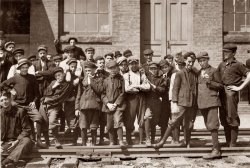
- The Pergola-Casino: 1911
- Lake George, New York, circa 1911. "The Pergola-Casino, Fort William Henry Hotel." Two years après-feu. ... Hotel's history here .
The car On the left is a 1911 Packard. The plate is visible so if the records existed we would know whose car it was.
New in 1911 From https://www.fortwilliamhenry.com/resort-overview/history/:
... Posted by Dave - 11/09/2019 - 7:50pm -
![The Pergola-Casino: 1911 Lake George, New York, circa 1911. "The Pergola-Casino, Fort William Henry Hotel." Two years après-feu. 8x10 inch dry plate glass negative, Detroit Publishing Company. View full size.
The GrottoAfter visiting The Casino, we might go to The Grotto, provided that it has been rebuilt as well. Read the Hotel's history here.
The carOn the left is a 1911 Packard. The plate is visible so if the records existed we would know whose car it was.
New in 1911From https://www.fortwilliamhenry.com/resort-overview/history/:
"A year after the fire [in 1909], the hotel’s owners, the Delaware & Hudson Railroad, committed to rebuilding a much smaller hotel that would accommodate around 150 guests. On June 17, 1911, the second Fort William Henry Hotel opened for business. The white stucco building was 3 stories with a red tile roof, and was designed to be less susceptible to a catastrophic fire, like the one that destroyed the first hotel.
While the hotel itself was smaller, the emphasis on being a lavish resort remained. The most notable new feature was the marble and concrete pergola along the lakefront. A walkway connected the hotel to the pergola. Guests would cross a bridge over the shore road which is now the location of the Beach Road public parking lot. People danced to music provided by a resident orchestra, and enjoyed refreshments while taking in the picturesque view."
(The Gallery, Cars, Trucks, Buses, DPC, Eateries & Bars, Kids)](https://www.shorpy.com/files/images/SHORPY-4a24324a.thumbnail.jpg)
- Doffing All Summer: 1911
- September 1911. Winchendon, Massachusetts. "Batiste Joseph. Doffer in Glenallen Mill. ... in the mill. He was 13 years old.
Doffing All Summer: 1911 This is Joe Manning, of the Lewis Hine Project. Hine took 40 child ... Posted by Dave - 01/07/2009 - 5:35am -
![Doffing All Summer: 1911 September 1911. Winchendon, Massachusetts. "Batiste Joseph. Doffer in Glenallen Mill. Father and mother said he is 12 years old, has been doffing all summer, will go to school. Query: Will he go to school? Another boy, 13 years old in this mill, said, 'I'll stay at work until they come after me.' Older sister and parents illiterate." Photo and caption by Lewis Wickes Hine. View full size.
Mill workersMy dad graduated 6th grade in Greenville, SC in 1927 and went straight down the street to the Woodside Mill and got a job working in the mill. He was 13 years old.
Doffing All Summer: 1911This is Joe Manning, of the Lewis Hine Project. Hine took 40 child labor photos in Winchendon, and for the past three months, I have been researching all of them. Winchendon is just a 75-minute drive from my home. I interviewed one of this boy's children. It's a remarkable story, one I have not committed to print as yet. You can see the Winchendon results I have published so far at the link below. There is still much to tell.
www.morningsonmaplestreet.com/winchendon.html
Going to schoolI would have guessed that this picture was taken in front of a school. Those marks on the front door look like they were made by chalk board erasers.
[They probably were, but this isn't a school. - Dave]
Doffing in front of schoolThose are definitely eraser "clapper" marks - used to be a privilege if the teacher chose you to do the "clapping."
[This is one of the Glenallen Mill buildings. Plenty of businesses, factories and churches had chalkboards. - Dave]
Sharing the history. I have been aware of the Hine photos for a while, though never presumed the history beyond the image. Thank you so much for sharing your project.
Doffing All SummerThis is Joe Manning. I have completed my story of this boy.
http://morningsonmaplestreet.com/2014/11/26/elias-joseph-page-one/
(The Gallery, Kids, Lewis Hine)](https://www.shorpy.com/files/images/02308u1.thumbnail.jpg)
- Harvard Varsity: 1911
- Harvard Varsity, 1911. View full size. George Grantham Bain Collection. Evidence that not ... guy The little guy on the end looks overheated.
1911? The sweater worn by the man on the right reads 1913.
[That's ... Posted by Dave - 09/07/2011 - 6:16pm -
![Harvard Varsity: 1911 Harvard Varsity, 1911. View full size. George Grantham Bain Collection. Evidence that not every rowing squad in the 1910's was fashion-challenged.
Other photoI think they are referring to the other other photo of the Penn rowing team. :)
Harvard fashionIt looks like country club meets African safari. I might dress like that this weekend.
Lil guyThe little guy on the end looks overheated.
1911?The sweater worn by the man on the right reads 1913.
[That's because he's in the Class of 1913 - Dave]
(The Gallery, G.G. Bain, Sports)](https://www.shorpy.com/files/images/09334u.thumbnail.jpg)
- Nipper Joe: 1911
- January 1911. Shaft #6, Pennsylvania Coal Co. mine at South Pittston. "At the close of ... the daughter in several weeks.
Nipper Joe: 1911 This is Joe Manning, of the Lewis Hine Project. I have completed my ... Posted by Dave - 09/08/2011 - 6:20pm -
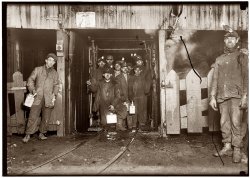
- Al and Joe: 1911
- September 1911. Indian Orchard, Massachusetts. "Alfred Gengreau, 20 Beaudry Street; ... Posted by Dave - 07/31/2023 - 7:11pm -
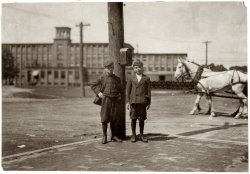
- Byron: 1911
- ... a day as a cutter at the Seacoast Sardine cannery. August 1911. View full size. Photo by Lewis Wickes Hine.
Fascinating This ... relatives and for Joe Manning!
Byron, the fish cutter: 1911 "He was extremely brilliant. If he had had money, he certainly would ... Posted by Dave - 09/08/2011 - 10:57am -
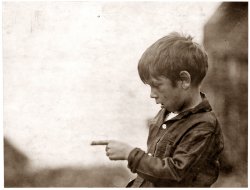
- Aerial Washington: 1911
- Circa 1911. "Washington from Washington Monument." Points of interest in this first ... Surprising lack of motorized vehicles for ca. 1911.
[Here are seven. - Dave]
Cargo Tram Now there's something ... - this was before I switched to digital.)
DC in 1911 What a great photo. More of these buildings than one would think are ... Posted by Dave - 04/09/2014 - 1:24pm -
![Aerial Washington: 1911 Circa 1911. "Washington from Washington Monument." Points of interest in this first installment of a six-segment panoramic view include B Street (today's Constitution Avenue), running diagonally from the Potomac Electric powerhouse at lower left; Louisiana Avenue, branching off in the general direction of Union Station at upper right; the Old Post Office and its clock tower at left-center across Pennsylvania Avenue from the Raleigh Hotel under construction; the Agriculture Department greenhouses in the foreground with a corner of the Smithsonian "National Museum" at far right, just below Center Market; Liberty Market at upper left, below what looks to be a vast tent encampment; and, at right-upper-center, the Pension Office north of Judiciary Square and the District Court House. 8x10 glass negative, Detroit Publishing Co. View full size.
"Tents"All those tents are actually slate turret roofs on top of rowhouses. Very typically, a pyramid shaped slate turret would top off the projecting bay of a DC rowhouse. All four sides would have been slated. Slate, because of its mineral content (lots of mica) can be very reflective at certain angles, hence the white appearance.
[Conical was also popular. - Dave]
SurprisingSurprising lack of motorized vehicles for ca. 1911.
[Here are seven. - Dave]
Cargo TramNow there's something I had never really thought of: street cars for freight; a forerunner of today's semi-rigs I suppose. There's one being loaded/unloaded in front of the lumber yard.
First of six?Great! Bring them on!
Kann's Busy Corneraka Kann's Department Store. A good history of the life and death of the buildings can be found here.
[More here. - Dave]
+86Below is the same view taken in December of 1997. (Please excuse my still-limited scanning talents - this was before I switched to digital.)
DC in 1911What a great photo. More of these buildings than one would think are still there. The "District Court House" south (right) of the great Pension Building on Judiciary Square is the original DC City hall, started in 1820. After a several-years-long redo, it now houses in grand style the DC Court of Appeals (the state supreme court for the District.) Peeking around the office building to the left of the City Hall on 5th Street NW is the then-new US Court of Appeals building, which housed what is now the US Court of Appeals for the DC Circuit until 1952, when it moved to the new federal courthouse on Constitution Avenue (now the Prettyman Courthouse.) The old US Court of Appeals building now houses the US Court of Appeals for the Armed Forces, on which I am privileged to sit. It is an exquisite little building, quite well-preserved, with many of its original furnishings.
Ford's TheaterI had a thought that Ford's Theater was off in this general direction, so I took a look. Not being all that familiar with D.C. I'm wondering if that is the peak of the theater with porthole just above the scaffolding atop the hotel under construction.
(The Gallery, D.C., DPC, Railroads, Stores & Markets, Streetcars)](https://www.shorpy.com/files/images/SHORPY_4a10391a.thumbnail.jpg)
- New Train: 1911
- ... Photographer unknown. View full size.
New Train: 1911 Tighter information: new locomotive (a "train" is what it pulls). ... Posted by kevhum - 09/23/2011 - 12:02am -
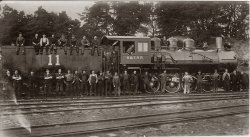
- Clarence Noel: 1911
- September 1911. Indian Orchard, Massachusetts. "Clarence Noel, 138 Main Street, Indian ... Posted by Dave - 08/01/2023 - 4:24pm -
